Near-Infrared Synaptic Responses of WSe2 Artificial Synapse Based on Upconversion Luminescence from Lanthanide Doped Nanoparticles
Abstract
1. Introduction
2. Results and Discussion
2.1. NIR-Responsive Artificial Synapse
2.2. Mechanism Analysis of UCNPs-WSe2 Synaptic Device
2.3. Properties of UCNPs-WSe2 Synaptic Device
2.4. Learning Experience Behavior and Handwritten Digital Image Recognition
2.5. Possible Application Directions of UCNPs-WSe2 Device
3. Materials and Methods
3.1. WSe2 Synthesis
3.2. Preparation of UCNPs (NaYF4: 20%Yb3+, 0.5%Tm3+)
3.3. UCNPs-WSe2 Composite Material
3.4. Fabrication of Transistor
3.5. Characterization
4. Conclusions
Supplementary Materials
Author Contributions
Funding
Institutional Review Board Statement
Informed Consent Statement
Data Availability Statement
Conflicts of Interest
References
- Merolla, P.A.; Arthur, J.V.; Alvarez Icaza, R.; Cassidy, A.S.; Sawada, J.; Akopyan, F.; Jackson, B.L.; Imam, N.; Guo, C.; Nakamura, Y.; et al. A Million Spiking-Neuron Integrated Circuit with a Scalable Communication Network and Interface. Science 2014, 345, 668–673. [Google Scholar] [CrossRef]
- Muir, D.R.; Sheik, S. The Road to Commercial Success for Neuromorphic Technologies. Nat. Commun. 2025, 16, 3586. [Google Scholar] [CrossRef]
- Wu, W.Q.; Wang, C.F.; Han, S.T.; Pan, C.F. Recent Advances in Imaging Devices: Image Sensors and Neuromorphic Vision Sensors. Rare Met. 2024, 43, 5487–5515. [Google Scholar] [CrossRef]
- Liang, Y.; Li, H.; Tang, H.; Zhang, C.; Men, D.; Mayer, D. Bioinspired Electrolyte-Gated Organic Synaptic Transistors: From Fundamental Requirements to Applications. Nano-Micro Lett. 2025, 17, 198. [Google Scholar] [CrossRef] [PubMed]
- Kudithipudi, D.; Schuman, C.; Vineyard, C.M.; Pandit, T.; Merkel, C.; Kubendran, R.; Aimone, J.B.; Orchard, G.; Mayr, C.; Benosman, R.; et al. Neuromorphic Computing at Scale. Nature 2025, 637, 801–812. [Google Scholar] [CrossRef] [PubMed]
- Lian, H.; Wang, S.; Qin, Z.; Dou, Z.; Cheng, X.; Lan, G.; Li, X.; Liu, A.; Dong, Q. Transparent and Flexible Organic Bulk Heterojunction Photonic Synapse for Neuromorphic Computing and Reflex Arc Behavior. Device 2025, 100749. [Google Scholar] [CrossRef]
- Mu, B.; Guo, L.; Liao, J.; Xie, P.; Ding, G.; Lv, Z.; Zhou, Y.; Han, S.; Yan, Y. Near-Infrared Artificial Synapses for Artificial Sensory Neuron System. Small 2021, 17, 2103837. [Google Scholar] [CrossRef]
- Chen, K.; Hu, H.; Song, I.; Gobeze, H.B.; Lee, W.J.; Abtahi, A.; Schanze, K.S.; Mei, J. Organic Optoelectronic Synapse Based on Photon-Modulated Electrochemical Doping. Nat. Photon. 2023, 17, 629–637. [Google Scholar] [CrossRef]
- Dan, S.; Paramanik, S.; Pal, A.J. Introducing Chiro-Optical Activities in Photonic Synapses for Neuromorphic Computing and In-Memory Logic Operations. ACS Nano 2024, 18, 14457–14468. [Google Scholar] [CrossRef]
- Wang, X.; Zhang, L.; Zhao, Y.; Qin, Z.; Hu, B.; Zhang, L.; Jiang, Y.; Wang, Q.; Liang, Z.; Tang, X.; et al. Electro-Optically Configurable Synaptic Transistors With Cluster-Induced Photoactive Dielectric Layer for Visual Simulation and Biomotor Stimuli. Adv. Mater. 2024, 36, 2406977. [Google Scholar] [CrossRef]
- Gentili, P.L.; Rightler, A.L.; Heron, B.M.; Gabbutt, C.D. Extending Human Perception of Electromagnetic Radiation to the UV Region through Biologically Inspired Photochromic Fuzzy Logic (BIPFUL) Systems. Chem. Commun. 2016, 52, 1474–1477. [Google Scholar] [CrossRef]
- Guo, Z.; Liu, J.; Han, X.; Ma, F.; Rong, D.; Du, J.; Yang, Y.; Wang, T.; Li, G.; Huang, Y.; et al. High-Performance Artificial Synapse Based on CVD-Grown WSe2 Flakes with Intrinsic Defects. ACS Appl. Mater. Interfaces 2023, 15, 19152–19162. [Google Scholar] [CrossRef]
- Huang, M.; Ali, W.; Yang, L.; Huang, J.; Yao, C.; Xie, Y.; Sun, R.; Zhu, C.; Tan, Y.; Liu, X.; et al. Multifunctional Optoelectronic Synapses Based on Arrayed MoS2 Monolayers Emulating Human Association Memory. Adv. Sci. 2023, 10, 2300120. [Google Scholar] [CrossRef]
- Tang, H.; Anwar, T.; Jang, M.S.; Tagliabue, G. Light-Intensity Switching of Graphene/WSe2 Synaptic Devices. Adv. Sci. 2024, 11, 2309876. [Google Scholar] [CrossRef]
- Yu, J.; Yang, X.; Gao, G.; Xiong, Y.; Wang, Y.; Han, J.; Chen, Y.; Zhang, H.; Sun, Q.; Wang, Z.L. Bioinspired Mechano-Photonic Artificial Synapse Based on Graphene/MoS2 Heterostructure. Sci. Adv. 2021, 7, eabd9117. [Google Scholar] [CrossRef]
- Raza, W.; Ahmad, K.; Alvarado, F.G.; Oh, T.H. Progress in 2D MoS2-Based Advanced Materials for Hydrogen Evolution and Energy Storage Applications. Inorganics 2025, 13, 47. [Google Scholar] [CrossRef]
- Kalantar-zadeh, K.; Ou, J.Z.; Daeneke, T.; Strano, M.S.; Pumera, M.; Gras, S.L. Two-Dimensional Transition Metal Dichalcogenides in Biosystems. Adv. Funct. Mater. 2015, 25, 5086–5099. [Google Scholar] [CrossRef]
- Zhao, Y.; Yu, H.B.; Zhao, C.Y.; Kong, D.N.; Wang, D.N.; Fu, L.Y.; Hu, Q.M.; Li, D.; Zang, T.Y.; Zheng, S.J.; et al. Anisotropy and Synaptic Plasticity in CrSBr/WSe2 Heterojunction for Advanced Neural Network Applications. Rare Met. 2025. [Google Scholar] [CrossRef]
- Chen, Z.; Li, Z.; Zhang, M.; Wang, Y.; Zhang, S.; Cheng, Y. Preparation of Non-Noble Metal Catalyst FeCo2O4/MoS2 for Production of Hydrogen and Oxygen by Electrochemical Decomposition of Water. Inorganics 2024, 12, 229. [Google Scholar] [CrossRef]
- Mak, K.F.; Lee, C.; Hone, J.; Shan, J.; Heinz, T.F. Atomically Thin MoS2: A New Direct-Gap Semiconductor. Phys. Rev. Lett. 2010, 105, 136805. [Google Scholar] [CrossRef]
- He, Y.L.; Yan, J.H.; Yang, Y.T.; Lu, Y.X.; Liu, N.; Chen, P.; Liu, X.F.; Qiu, J.R.; Xu, B.B. Achieving Enhanced Linear and Nonlinear Optical Absorption in a (PEA)2PbI4/WS2 Heterojunction by Efficient Energy Transfer. Rare Met. 2025. [Google Scholar] [CrossRef]
- Teli, A.M.; Mane, S.M.; Mishra, R.K.; Jeon, W.; Shin, J.C. Unveiling the Electrocatalytic Performances of the Pd-MoS2 Catalyst for Methanol-Mediated Overall Water Splitting. Inorganics 2025, 13, 21. [Google Scholar] [CrossRef]
- Dhankhar, D.; Li, R.; Nagpal, A.; Chen, J.; Cesario, T.C.; Rentzepis, P.M. Extending Human Vision to Infrared and Ultraviolet Light: A Study Using Micro-Particles and Fluorescent Molecules. IEEE Access 2020, 8, 73890–73897. [Google Scholar] [CrossRef]
- Das, S.; Pal, V.; Mukherjee, S.; Das, S.; Tiwary, C.S.; Ray, S.K. Multi-Wavelength Optoelectronic Synaptic Transistors Based on Transition Metal Telluride-Sulfide Heterostructures. Adv. Opt. Mater. 2024, 12, 2400037. [Google Scholar] [CrossRef]
- Hu, Y.; Yang, H.; Huang, J.; Zhang, X.; Tan, B.; Shang, H.; Zhang, S.; Feng, W.; Zhu, J.; Zhang, J.; et al. Flexible Optical Synapses Based on In2Se3/MoS2 Heterojunctions for Artificial Vision Systems in the Near-Infrared Range. ACS Appl. Mater. Interfaces 2022, 14, 55839–55849. [Google Scholar] [CrossRef]
- Tan, F.; Chang, C.; Zhang, N.; An, J.; Liu, M.; Zhao, X.; Che, M.; Liu, Z.; Shi, Y.; Li, Y.; et al. Physisorption-Assistant Optoelectronic Synaptic Transistors Based on Ta2NiSe5/SnS2 Heterojunction from Ultraviolet to near-Infrared. Light. Sci. Appl. 2025, 14, 122. [Google Scholar] [CrossRef]
- Zhai, Y.; Zhou, Y.; Yang, X.; Wang, F.; Ye, W.; Zhu, X.; She, D.; Lu, W.D.; Han, S.T. Near Infrared Neuromorphic Computing via Upconversion-Mediated Optogenetics. Nano Energy 2020, 67, 104262. [Google Scholar] [CrossRef]
- Jeong, B.H.; Lee, J.; Ku, M.; Lee, J.; Kim, D.; Ham, S.; Lee, K.T.; Kim, Y.B.; Park, H.J. RGB Color-Discriminable Photonic Synapse for Neuromorphic Vision System. Nano-Micro Lett. 2025, 17, 78. [Google Scholar] [CrossRef]
- Pan, Y.; Wang, Y.; Ye, M.; Quhe, R.; Zhong, H.; Song, Z.; Peng, X.; Yu, D.; Yang, J.; Shi, J.; et al. Monolayer Phosphorene–Metal Contacts. Chem. Mat. 2016, 28, 2100–2109. [Google Scholar] [CrossRef]
- Somvanshi, D.; Jit, S. Advances in 2D Materials Based Mixed-Dimensional Heterostructures Photodetectors: Present Status and Challenges. Mater. Sci. Semicond. Process 2023, 164, 107598. [Google Scholar] [CrossRef]
- Dixit, V.; Nair, S.; Joy, J.; Vyas, C.U.; Patel, A.B.; Chauhan, P.; Sumesh, C.K.; Narayan, S.; Jha, P.K.; Solanki, G.K.; et al. Growth and Application of WSe2 Single Crystal Synthesized by DVT in Thin Film Hetero-Junction Photodetector. Eur. Phys. J. B 2019, 92, 118. [Google Scholar] [CrossRef]
- Hao, Y.; Zhang, S.; Fan, C.; Liu, J.; Hao, S.; Lu, X.; Zhou, J.; Qiu, M.; Li, J.; Hao, G. Te Nanomesh-Monolayer WSe2 Vertical van Der Waals Heterostructure for High-Performance Photodetector. Appl. Phys. Lett. 2025, 126, 031904. [Google Scholar] [CrossRef]
- Rana, J.S.; Jit, S. A Low-Cost Solution-Processed PTB7-Based MSM Visible Photodetector. IEEE Trans. Electron. Devices 2024, 71, 1208–1213. [Google Scholar] [CrossRef]
- Grillo, A.; Di Bartolomeo, A. A Current–Voltage Model for Double Schottky Barrier Devices. Adv. Electron. Mater. 2021, 7, 2000979. [Google Scholar] [CrossRef]
- Singh, S.; Jit, S. Thermally Grown MoSe2 Thin Film Based MSM Broadband Photodetector. IEEE Photonics Technol. Lett. 2024, 36, 1105–1108. [Google Scholar] [CrossRef]
- Pataniya, P.; Zankat, C.K.; Tannarana, M.; Sumesh, C.K.; Narayan, S.; Solanki, G.K.; Patel, K.D.; Pathak, V.M.; Jha, P.K. Paper-Based Flexible Photodetector Functionalized by WSe2 Nanodots. ACS Appl. Nano Mater. 2019, 2, 2758–2766. [Google Scholar] [CrossRef]
- Zhao, W.; Ghorannevis, Z.; Amara, K.K.; Pang, J.R.; Toh, M.; Zhang, X.; Kloc, C.; Tan, P.H.; Eda, G. Lattice Dynamics in Mono- and Few-Layer Sheets of WS2 and WSe2. Nanoscale 2013, 5, 9677. [Google Scholar] [CrossRef]
- Wen, D.P.; Chen, P.; Liang, Y.; Mo, X.M.; Pan, C.F. Regulated Polarization Degree of Upconversion Luminescence and Multiple Anti-Counterfeit Applications. Rare Met. 2024, 43, 2172–2183. [Google Scholar] [CrossRef]
- Zheng, W.; Huang, P.; Gong, Z.; Tu, D.; Xu, J.; Zou, Q.; Li, R.; You, W.; Bünzli, J.-C.G.; Chen, X. Near-Infrared-Triggered Photon Upconversion Tuning in All-Inorganic Cesium Lead Halide Perovskite Quantum Dots. Nat. Commun. 2018, 9, 3462. [Google Scholar] [CrossRef]
- Tan, D.; Zhang, Z.; Shi, H.; Sun, N.; Li, Q.; Bi, S.; Huang, J.; Liu, Y.; Guo, Q.; Jiang, C. Bioinspired Artificial Visual-Respiratory Synapse as Multimodal Scene Recognition System with Oxidized-Vacancies MXene. Adv. Mater. 2024, 36, 2407751. [Google Scholar] [CrossRef]
- Wang, Y.; Shan, W.; Li, H.; Zhong, Y.; Wustoni, S.; Uribe, J.; Chang, T.; Musteata, V.E.; Yue, W.; Ling, H.; et al. An Optoelectrochemical Synapse Based on a Single-Component n-Type Mixed Conductor. Nat. Commun. 2025, 16, 1615. [Google Scholar] [CrossRef]
- Wang, L.; Wang, L.; Ye, X.Y.; Xu, X.H.; Shang, L.Y.; Li, Y.W.; Zhang, J.Z.; Zhu, L.Q.; Hu, Z.G. Thermally Modulated Photoelectronic Synaptic Behavior in HfS2/VO2 Heterostructure. Rare Met. 2024, 43, 3798–3809. [Google Scholar] [CrossRef]
- Liu, Z.; Wang, Y.; Zhang, Y.; Sun, S.; Zhang, T.; Zeng, Y.; Hu, L.; Zhuge, F.; Lu, B.; Pan, X.; et al. Harnessing Defects in SnSe Film via Photo-Induced Doping for Fully Light-Controlled Artificial Synapse. Adv. Mater. 2025, 37, 2410783. [Google Scholar] [CrossRef]
- Zheng, X.; Dong, M.; Li, Q.; Wang, L.; Liu, Y.; Di, X.; Hua, Q.; Wang, L.; Meng, J.; Li, Z. Retina-Inspired Artificial Synapses with UV Modulated and Immediate Switchable Plasticity. Adv. Funct. Mater. 2025, 2420612. [Google Scholar] [CrossRef]
- Liu, X.; Huang, M.; Zou, X.; Ali, W.; Rehman, S.U.; Li, J.; Li, Z.; Xiang, L.; Pan, A. Alcohol-Sensitive MoS2 Optoelectronic Synapses for Mimicking Human-like Visual Adaptation. InfoMat 2025, e70019. [Google Scholar] [CrossRef]
- Gu, X.; Zhou, M.; Zhao, Y.; Zhang, Q.; Zhang, J.; Huang, Y.; Lu, S. Realize Ultralow-Energy-Consumption Photo-Synaptic Device Based on a Single (Al, Ga)N Nanowire for Neuromorphic Computing. Nano Res. 2024, 17, 1933–1941. [Google Scholar] [CrossRef]
- Gong, Y.; Xie, P.; Xing, X.; Lv, Z.; Xie, T.; Zhu, S.; Hsu, H.H.; Zhou, Y.; Han, S.T. Bioinspired Artificial Visual System Based on 2D WSe2 Synapse Array. Adv. Funct. Mater. 2023, 33, 2303539. [Google Scholar] [CrossRef]
- Gracheva, E.O.; Ingolia, N.T.; Kelly, Y.M.; Cordero-Morales, J.F.; Hollopeter, G.; Chesler, A.T.; Sánchez, E.E.; Perez, J.C.; Weissman, J.S.; Julius, D. Molecular Basis of Infrared Detection by Snakes. Nature 2010, 464, 1006–1011. [Google Scholar] [CrossRef]
- Pang, X.; Wang, Y.; Zhu, Y.; Zhang, Z.; Xiang, D.; Ge, X.; Wu, H.; Jiang, Y.; Liu, Z.; Liu, X.; et al. Non-Volatile Rippled-Assisted Optoelectronic Array for All-Day Motion Detection and Recognition. Nat. Commun. 2024, 15, 1613. [Google Scholar] [CrossRef]
- Luan, W.; Zhao, Z.; Li, H.; Zhai, Y.; Lv, Z.; Zhou, K.; Xue, S.; Zhang, M.; Yan, Y.; Cao, Y.; et al. Near-Infrared Response Organic Synaptic Transistor for Dynamic Trace Extraction. J. Phys. Chem. Lett. 2024, 15, 8845–8852. [Google Scholar] [CrossRef]
- Chen, P.; Pan, J.; Gao, W.; Wan, B.; Kong, X.; Cheng, Y.; Liu, K.; Du, S.; Ji, W.; Pan, C.; et al. Anisotropic Carrier Mobility from 2H WSe2. Adv. Mater. 2022, 34, 2108615. [Google Scholar] [CrossRef]
- Wen, D.; Zuo, S.; Huang, C.; Tan, Z.; Lu, F.; Liang, Y.; Mo, X.; Lin, T.; Cao, S.; Qiu, J.; et al. Tunable Excitation Polarized Upconversion Luminescence and Reconfigurable Double Anti-Counterfeiting from Er3+ Doped Single Nanorods. Adv. Opt. Mater. 2023, 11, 2301126. [Google Scholar] [CrossRef]
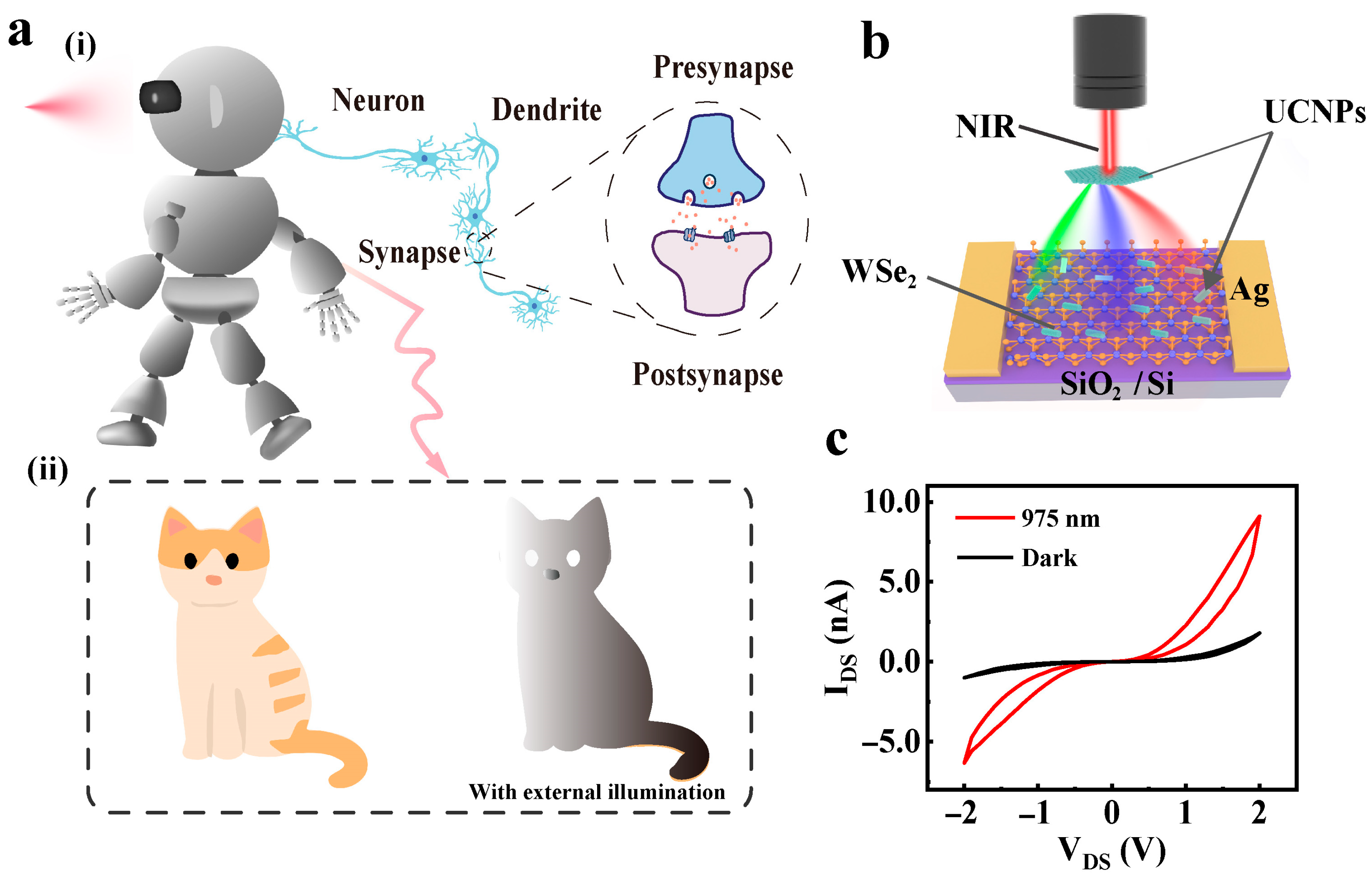
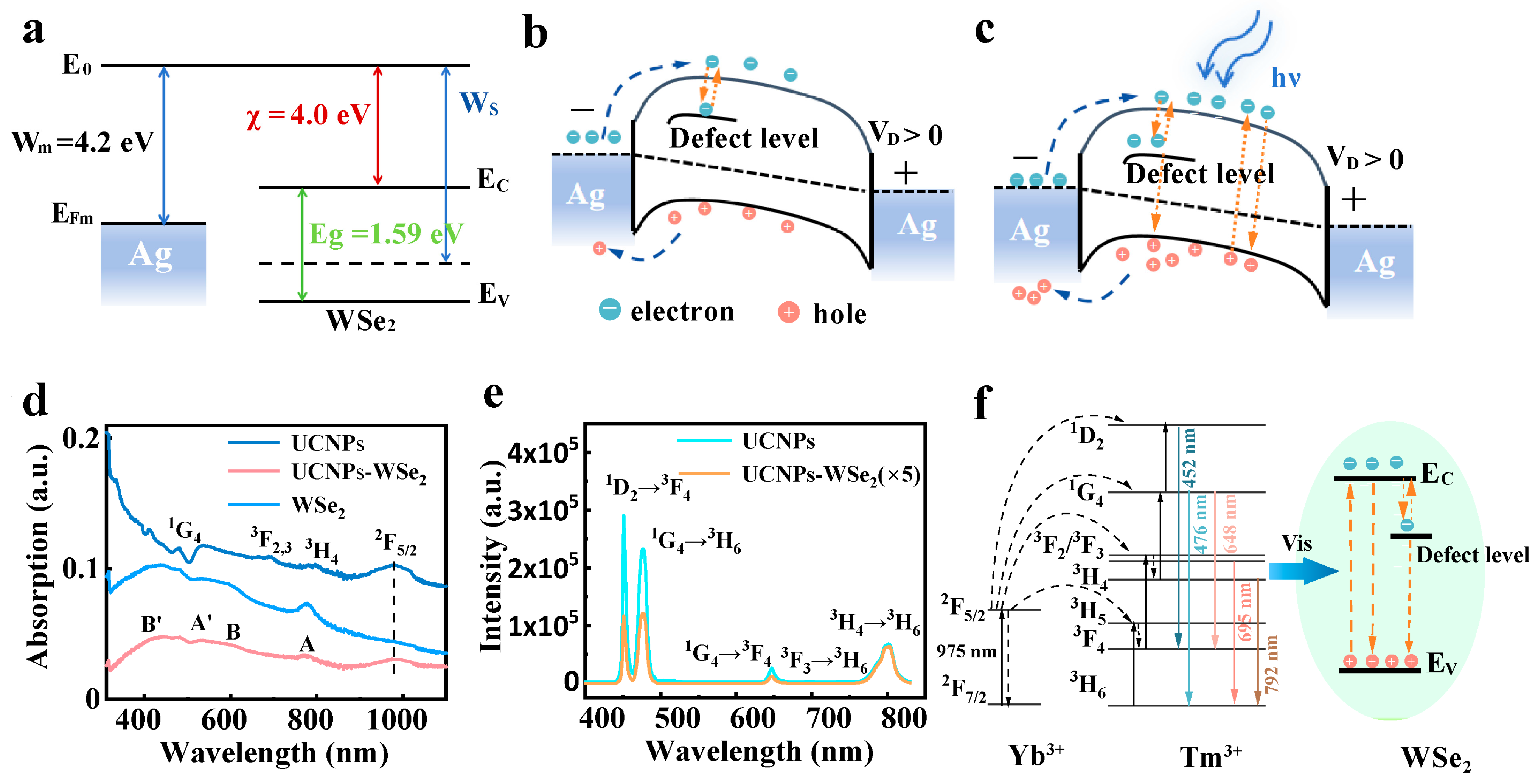
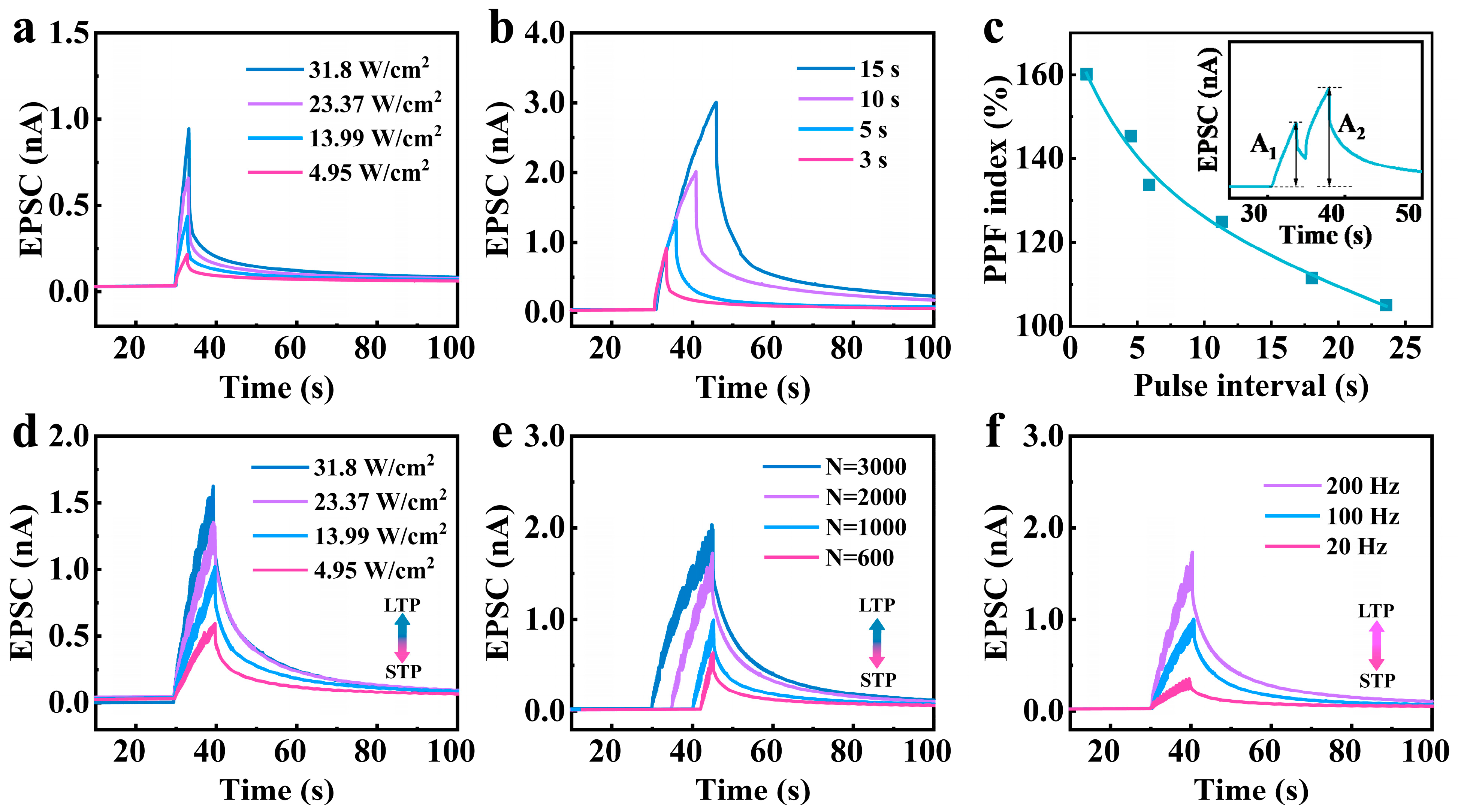
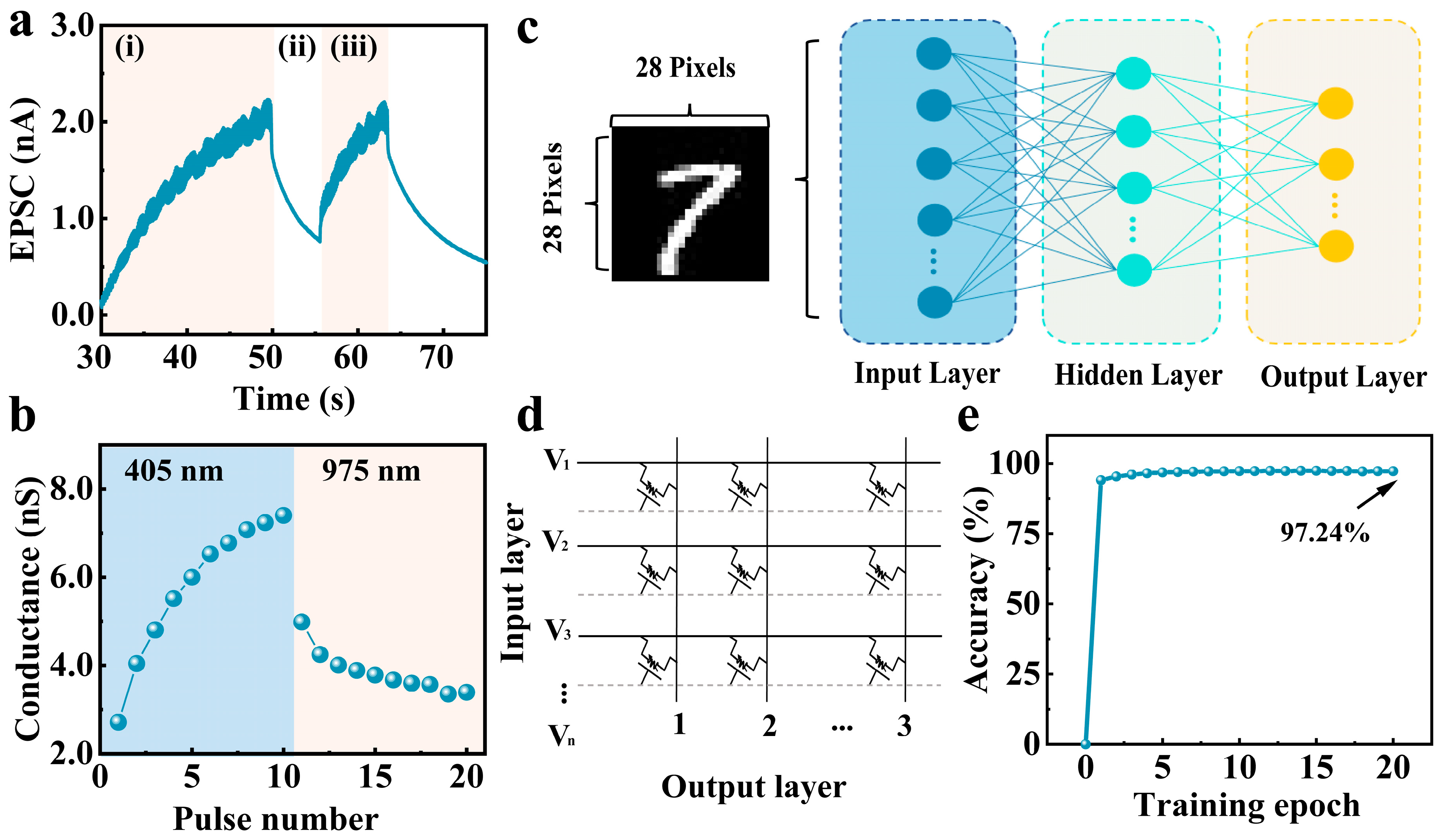
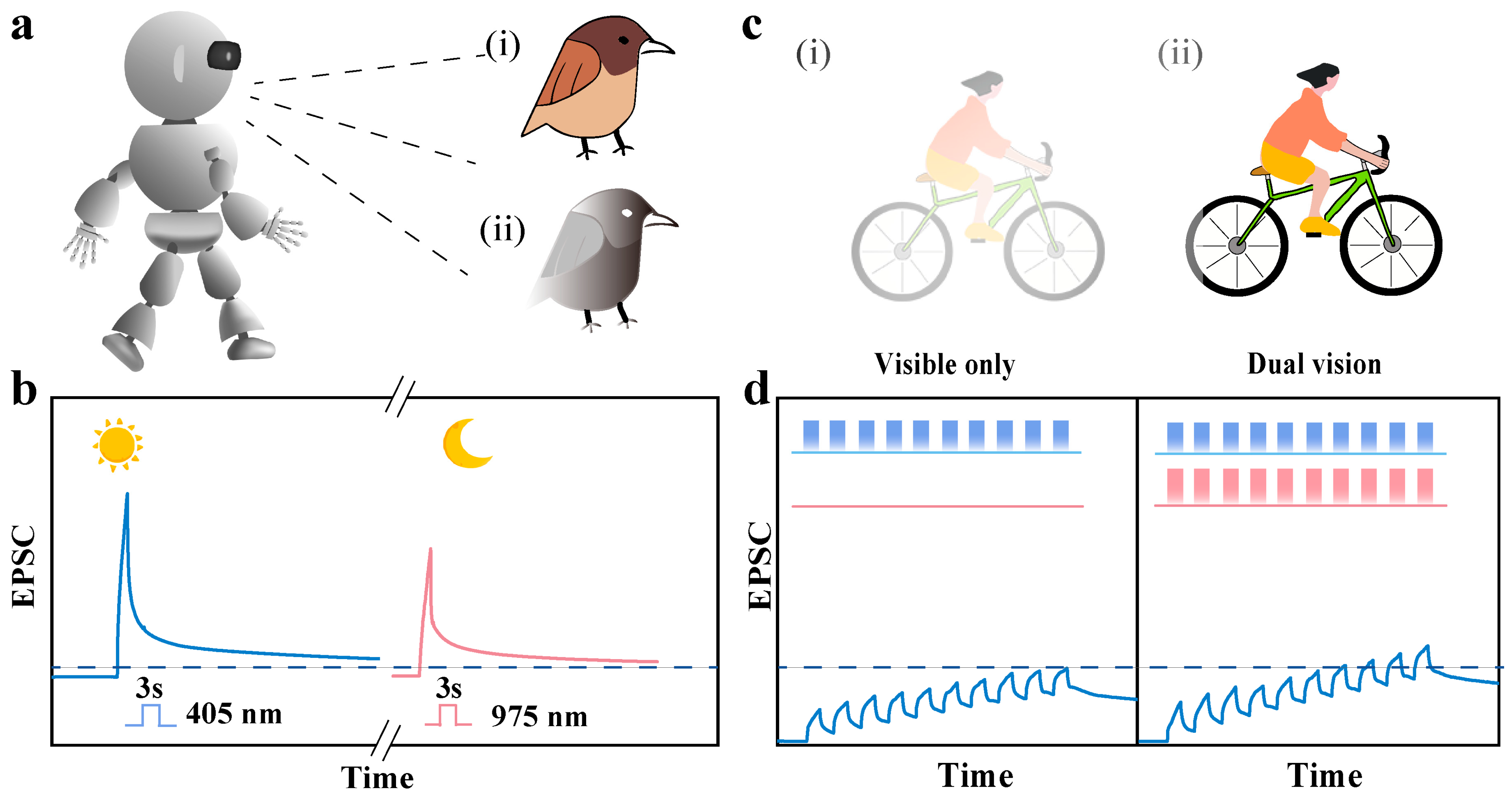
Disclaimer/Publisher’s Note: The statements, opinions and data contained in all publications are solely those of the individual author(s) and contributor(s) and not of MDPI and/or the editor(s). MDPI and/or the editor(s) disclaim responsibility for any injury to people or property resulting from any ideas, methods, instructions or products referred to in the content. |
© 2025 by the authors. Licensee MDPI, Basel, Switzerland. This article is an open access article distributed under the terms and conditions of the Creative Commons Attribution (CC BY) license (https://creativecommons.org/licenses/by/4.0/).
Share and Cite
Lu, Y.; Chen, C.; Sun, Q.; Zhang, N.; Lv, K.; Chen, Z.; He, Y.; Tang, H.; Chen, P. Near-Infrared Synaptic Responses of WSe2 Artificial Synapse Based on Upconversion Luminescence from Lanthanide Doped Nanoparticles. Inorganics 2025, 13, 236. https://doi.org/10.3390/inorganics13070236
Lu Y, Chen C, Sun Q, Zhang N, Lv K, Chen Z, He Y, Tang H, Chen P. Near-Infrared Synaptic Responses of WSe2 Artificial Synapse Based on Upconversion Luminescence from Lanthanide Doped Nanoparticles. Inorganics. 2025; 13(7):236. https://doi.org/10.3390/inorganics13070236
Chicago/Turabian StyleLu, Yaxian, Chuanwen Chen, Qi Sun, Ni Zhang, Kun Lv, Zhiling Chen, Yuelan He, Haowen Tang, and Ping Chen. 2025. "Near-Infrared Synaptic Responses of WSe2 Artificial Synapse Based on Upconversion Luminescence from Lanthanide Doped Nanoparticles" Inorganics 13, no. 7: 236. https://doi.org/10.3390/inorganics13070236
APA StyleLu, Y., Chen, C., Sun, Q., Zhang, N., Lv, K., Chen, Z., He, Y., Tang, H., & Chen, P. (2025). Near-Infrared Synaptic Responses of WSe2 Artificial Synapse Based on Upconversion Luminescence from Lanthanide Doped Nanoparticles. Inorganics, 13(7), 236. https://doi.org/10.3390/inorganics13070236





